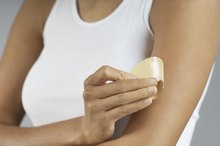Reaction to Fabric Softener
Fabric softeners, also known as fabric conditioners, are added to laundry during the rinse cycle to soften clothing and reduce static cling. Many products also contain perfumes to impart fragrance to clothing and linens. A thin coating of the softener remains on the fabric at completion of the wash cycle. Fabric softeners contain an array of chemicals, some of which can irritate the skin of sensitive individuals. Babies, young children, older adults and people with eczema or other skin conditions are more likely to experience a reaction to fabric softener due to increased skin sensitivity.
Contact Dermatitis
Contact dermatitis refers to a skin reaction provoked by direct exposure to a triggering substance. Contact dermatitis occurs in two forms, irritant and allergic 2. Irritant contact dermatitis is more common than the allergic form 2. With irritant contact dermatitis, the triggering substances in the fabric softener irritate and inflame the exposed skin, but do not cause an allergic reaction. With allergic contact dermatitis, one or more specific chemicals in the product induces an allergic skin reaction.
- Contact dermatitis refers to a skin reaction provoked by direct exposure to a triggering substance.
- With allergic contact dermatitis, one or more specific chemicals in the product induces an allergic skin reaction.
Signs and Symptoms
Allergic Reaction to Medical Adhesive
Learn More
The signs and symptoms of irritant and allergic contact dermatitis are often nearly identical, particularly with the type of low-level, widespread skin exposure that occurs with fabric softener. For most people, itchiness is the most prominent and bothersome symptom. Any area of the skin exposed to clothing or linens that have been rinsed in the offending product can be affected. Areas of friction between the skin and clothing -- such as the waist, wrists, neck, armpits and groin area -- are most likely to be involved as the friction allows more chemical penetration into the skin. A pink or red rash is common, which may be accompanied by a mild stinging sensation or pain. Hives are also possible. With ongoing exposure, the skin may appear scaly.
- The signs and symptoms of irritant and allergic contact dermatitis are often nearly identical, particularly with the type of low-level, widespread skin exposure that occurs with fabric softener.
Diagnosis and Treatment
Determining the trigger for contact dermatitis can be challenging. If you’ve recently started using fabric softener or switched brands, this may be a tip-off that fabric conditioner might be to blame. Your doctor may recommend patch testing to help distinguish between irritant and allergic contact dermatitis 2. However, it is sometimes difficult to make this distinction, even with testing. An over-the-counter antihistamine, such as diphenhydramine (Benadryl), may be recommended to relieve itchiness. Short-term use of hydrocortisone cream might also be recommended if you have a bothersome rash.
With both types of contact dermatitis, avoiding exposure to the offending product is the cornerstone of treatment. If fabric softener is to blame for your skin reaction, all clothing and linens will need to be laundered to remove any residual fabric softener. Adding white vinegar or baking soda to your laundry during the rinse cycle may help get rid of the fabric conditioner in your clothes and make the fabrics feel a bit softer.
- Determining the trigger for contact dermatitis can be challenging.
- With both types of contact dermatitis, avoiding exposure to the offending product is the cornerstone of treatment.
Cautionary Notes
Skin Reaction to Lanolin
Learn More
See your doctor if you experience symptoms that might suggest contact dermatitis. Medical evaluation is needed as many conditions cause skin symptoms that can mimic contact dermatitis. Testing is important if your doctor suspects an allergy because as you might need to avoid all products that contain the offending chemical, not just fabric softener. Seek immediate medical care if you experience signs or symptoms of a severe allergic reaction, including: -- dizziness, lightheadedness or fainting -- swelling of the face, lips or tongue -- a choking sensation -- wheezing or difficulty breathing -- rapid heart rate
Reviewed and revised by: Tina M. St. John, M.D.
- See your doctor if you experience symptoms that might suggest contact dermatitis.
Related Articles
References
- Dermatitis: American Contact Dermatitis Society Contact Allergy Management Program: An Epidemiologic Tool to Quantify Ingredient Usage
- Expert Review of Clinical Immunology: Diagnostic Approach in Allergic and Irritant Contact Dermatitis
- Fisher's Contact Dermatitis, 6th Edition; Robert L. Rietschel, et al.
- Usatine RP, Riojas M. Diagnosis and management of contact dermatitis. Am Fam Physician. 2010;82(3):249-55.
- American Academy of Dermatology Association. CONTACT DERMATITIS: SIGNS AND SYMPTOMS
- Cleveland Clinic. Contact Dermatitis
- Veverka KK, Hall MR, Yiannias JA, et al. Trends in Patch Testing With the Mayo Clinic Standard Series, 2011-2015. Dermatitis. 2018;29(6):310-315. doi:10.1097/DER.0000000000000411
- Pacheco KA. Occupational dermatitis: How to identify the exposures, make the diagnosis, and treat the disease. Ann Allergy Asthma Immunol. 2018;120(6):583-591. doi:10.1016/j.anai.2018.04.013
- American Academy of Dermatology Association. How dermatologist treat contact dermatitis
- Contact Dermatitis. Medline Plus.
- Katta R, Schlichte M. Diet and dermatitis: Food triggers. J Clin Aesthet Dermatol. March 2014;30–36.
- Nguyen JC, Chesnut G, et al. Allergic contact dermatitis caused by lanolin (wool) alcohol contained in an emollient in three postsurgical patients. J Am Acad Dermatol. 2010;62:1064–5.
- Saary J, Qureshi R. A systematic review of contact dermatitis treatment and prevention. J Am Acad Dermatol. 2005;53:845–55.
- Wentworth AB, Yiannias JA, et at. Trends in patch testing, J Am Acad Dermatol. 2014;70:269–75.
Writer Bio
Alexis Jenkins writes to motivate others in areas of health including nutrition, fitness training and improving lifestyle choices. She graduated with a Bachelor of Science in health science from Brigham Young University-Idaho.









